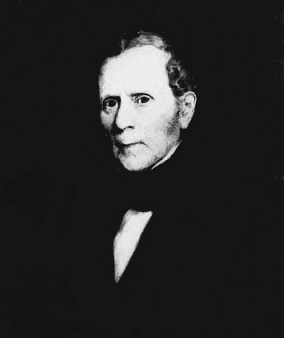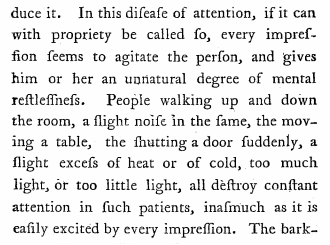The History of ADHD part 1: 1798

Attention to a long Winding Road
Scottish-born physician and author (1763-1856) Already In 1798 Sir Alexander Crichton described a mental state with al the essential features of the inattentive subtype of ADHD, the restlessness, problems with attention, the early onset and how it can affect the ability to perform in school. In the chapter of Attention in his book: An inquiry into the nature and origin of mental derangement: comprehending a concise system of the physiology and pathology of the human mind and a history of the passions and their effects – Crichton described a “mental restlessness” and: “The incapacity of attending with a necessary degree of constancy to any one object, almost always arises from an unnatural or morbid sensibility of the nerves, by which means this faculty is incessantly withdrawn from one impression to another.” It may be either born with a person or it may be the effect of accidental diseases “When born with a person it becomes evident at a very early period of life, and has a very bad effect, inasmuch as it renders him incapable of attending with constancy to any one object of education. But it seldom is in so great a degree as totally to impede all instruction; and what is very fortunate, it is generally diminished with age.
“The incapacity of attending with a necessary degree of constancy to any one object, almost always arises from an unnatural or morbid sensibility of the nerves, by which means this faculty is incessantly withdrawn from one impression to another. It may be either born with a person or it may be the effect of accidental diseases.”

When born with a person it becomes evident at a very early period of life, and has a very bad effect, inasmuch as it renders him incapable of attending with constancy to any one object of education. But it seldom is in so great a degree as totally to impede all instruction; and what is very fortunate, it is generally diminished with age.” page 271
“In this disease of attention, if it can with propriety be called so, every impression seems to agitate the person, and gives him or her an unnatural degree of mental restlessness. People walking up and down the room, a slight noise, in the same, the mowing a, the shutting a door suddenly, a flight excess of heat or of cold, to much light or to little light, all destroy constant attention in such patients. Inasmuch as it is easily is exited by every impression. page” 272
Ahead of his time
Alexander Crichton was almost two centuries ahead of his time in his observations of what is now known as the Inattention subtype of ADHD. He wrote about the salient features of this disorder, including problem with attention, restlessness, early onset, and how it can affect schooling, without any of the moral aspects introduced by George F. Still and later authors of the subject. Dr Crichton described all the essential features of the inattentive subtype of attention deficit hyperactivity disorder which were almost entirely consistent with the criteria for the inattentive subtype as portrayed in DSM-IV already in 1798.
Alexander Crichton part II
References:
Alexander Crichton : An inquiry into the nature and origin of mental derangement : comprehending a concise system of the physiology and pathology of the human mind and a history of the passions and their effects. 1798.
-Palmer, E. D., and Finger, S. 2001. An early description of ADHD(Inattention Subtype): Dr. Alexander Crichton and the “Mental Restlessness” (1798). Child Psychology and Psychiatry Reviews, 6, 66-73.
-Many Thanks to: Professor Russell A Barkley for kind advice and Professor Stanley Finger; at Washington University in St. Louis for kind advice and good spirit.
© All rights reserved by the author



